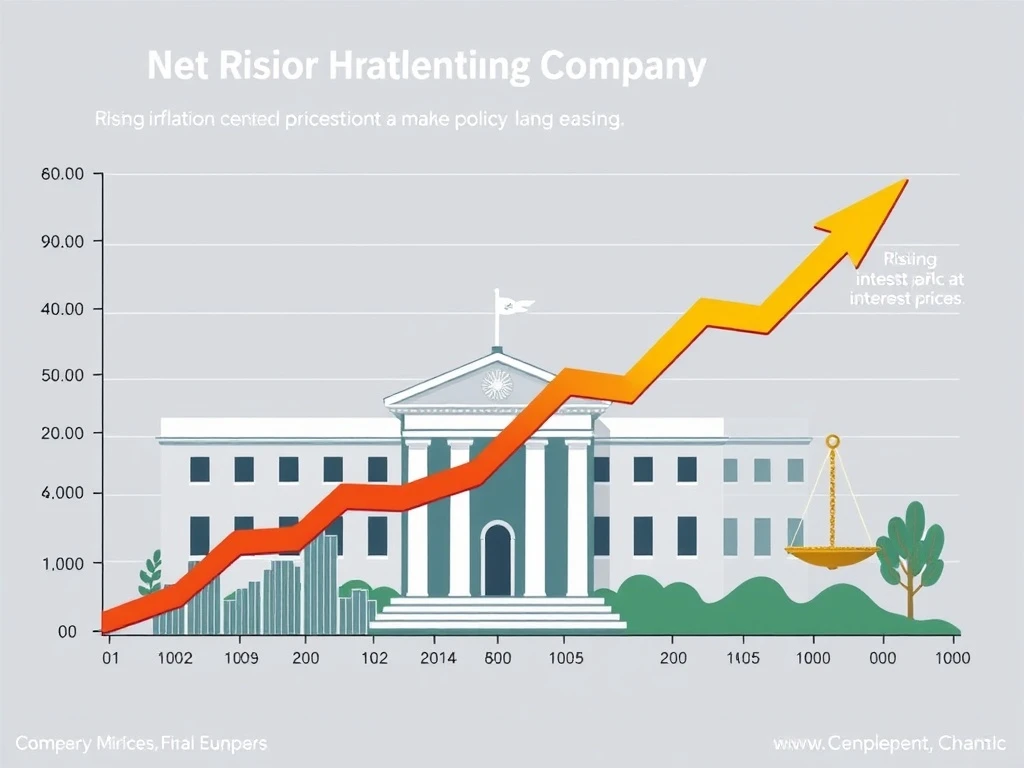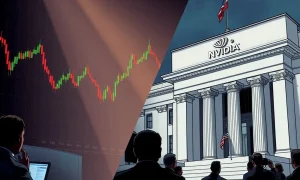The latest economic data has captured significant attention across financial markets. Recent reports indicate a notable increase in the Consumer Price Index (CPI), marking its biggest rise in six months. This surge in **CPI inflation** might initially suggest a tightening monetary policy. However, many analysts believe a Federal Reserve rate cut still appears to be a distinct possibility. Understanding this nuanced situation is crucial for businesses and entrepreneurs navigating today’s complex economic landscape. This article will delve into the specifics of the recent inflation data, the Federal Reserve’s perspective, and the factors keeping rate cuts on the table.
Understanding the Latest CPI Inflation Data
Recent reports confirmed a significant upward movement in the consumer price index. This index, a key measure of **CPI inflation**, tracks the average change over time in the prices paid by urban consumers for a market basket of consumer goods and services. The most recent figures show the largest monthly increase in six months. This development naturally raises questions about the trajectory of prices.
Specifically, the headline **CPI inflation** rate climbed more than anticipated. Various components contributed to this acceleration. For instance, energy prices saw a notable rebound. Housing costs, including rent and owners’ equivalent rent, continued their upward trend. Food prices also registered modest increases. This broad-based rise indicates persistent price pressures across several sectors of the economy. Therefore, policymakers are closely scrutinizing these detailed figures. They seek to understand whether these increases are temporary or indicative of a more entrenched inflationary environment.
The Federal Reserve’s Dual Mandate and CPI Inflation
The Federal Reserve operates under a dual mandate set by Congress. Its primary goals are to achieve maximum employment and maintain price stability. Price stability essentially means keeping **CPI inflation** at a healthy, sustainable level, typically around 2%. When inflation rises significantly, it erodes purchasing power. Consequently, it can destabilize the economy. The Fed uses various tools, primarily adjusting the federal funds rate, to influence economic activity and control inflation.
Higher interest rates generally slow down borrowing and spending. This can cool off an overheating economy and bring inflation down. Conversely, lower rates stimulate economic activity. This encourages investment and consumption. The recent uptick in **CPI inflation** presents a challenge to this delicate balancing act. The Fed must decide if the current inflationary pressures warrant a continued restrictive stance or if other factors allow for a pivot towards easing monetary policy. They constantly assess incoming data to make informed decisions.
Analyzing Core vs. Headline CPI Inflation
Economists often differentiate between headline and core **CPI inflation**. Headline CPI includes all items in the basket, notably volatile components like food and energy prices. These prices can fluctuate wildly due to external factors, such as geopolitical events or supply disruptions. Core CPI, conversely, excludes these volatile food and energy components. It aims to provide a clearer picture of underlying inflationary trends. The Federal Reserve often pays closer attention to core inflation.
The latest data showed that while headline **CPI inflation** surged, core inflation also remained elevated. This suggests that price pressures are not solely driven by transient factors like energy shocks. Instead, they reflect broader economic forces. For example, persistent strength in services inflation, particularly housing, contributes significantly to core CPI. Understanding this distinction is vital. It helps policymakers determine whether inflationary pressures are temporary or more deeply embedded within the economy. This analysis guides their long-term policy decisions.
Factors Contributing to the Recent CPI Inflation Surge
Several factors contributed to the recent upward movement in **CPI inflation**. One significant contributor has been the robust consumer demand. Despite higher interest rates, consumers have continued to spend, supported by a strong labor market and accumulated savings. This sustained demand allows businesses to pass on higher costs. Another factor is the lingering impact of supply chain disruptions. While many supply chains have improved, certain sectors still face bottlenecks. This keeps prices elevated for specific goods.
Furthermore, wage growth has played a role. A tight labor market has led to higher wages in many industries. While beneficial for workers, these increased labor costs can translate into higher prices for goods and services. Geopolitical events also contribute to inflationary pressures. For example, conflicts can disrupt energy markets, leading to higher oil and gas prices. These external shocks directly impact headline **CPI inflation**. The interplay of these domestic and international factors creates a complex inflationary environment.
The Nuances of the Labor Market and Inflationary Pressures
The labor market remains a critical variable for the Federal Reserve when assessing **CPI inflation**. A strong labor market, characterized by low unemployment rates and robust job creation, typically supports consumer spending. However, an exceptionally tight labor market can also lead to wage-price spirals. In such scenarios, rising wages push up production costs. Businesses then pass these costs onto consumers through higher prices. This, in turn, prompts demands for even higher wages.
Recent data indicates continued strength in the job market. Unemployment rates remain near historical lows. Wage growth, while moderating slightly, is still significant. The Fed carefully monitors these trends. They want to ensure that wage increases align with productivity gains. If wage growth outpaces productivity, it can fuel inflationary pressures. Therefore, the labor market’s balance between strength and overheating is a key consideration for future monetary policy decisions related to **CPI inflation**.
Why a Rate Cut Remains Possible Despite Rising CPI Inflation
Despite the recent uptick in **CPI inflation**, a Federal Reserve rate cut remains a distinct possibility. This seemingly contradictory stance stems from several considerations. Firstly, the Fed often looks beyond single data points. They consider the broader trend and forward-looking indicators. Many economists believe the underlying disinflationary trend is still intact. This means that while there might be short-term fluctuations, the overall direction of inflation is downwards.
Secondly, the Fed operates with a lag. The full impact of past interest rate hikes has not yet been completely felt across the economy. These previous actions are still working their way through the system. Therefore, the Fed might believe that existing policy is sufficiently restrictive to bring inflation down over time. Thirdly, other economic indicators provide a more mixed picture. While **CPI inflation** rose, some measures of economic activity show signs of cooling. For example, manufacturing output or certain consumer spending categories might be slowing. The Fed takes a holistic view, weighing all available data points before making decisions on interest rates.
Broader Economic Indicators Beyond CPI Inflation
The Federal Reserve considers a comprehensive array of economic indicators beyond just **CPI inflation**. One crucial measure is the Personal Consumption Expenditures (PCE) price index. The PCE is the Fed’s preferred inflation gauge. It tends to be less volatile than CPI and covers a broader range of goods and services. A lower PCE rate compared to CPI might give the Fed more flexibility. Additionally, the Fed monitors wage growth, consumer sentiment, and business investment. These indicators provide insights into the underlying health and momentum of the economy.
Furthermore, global economic conditions and geopolitical developments play a significant role. Disruptions to global supply chains or sudden shifts in commodity prices can impact domestic inflation. The Fed also assesses financial market conditions. These include bond yields, stock market performance, and credit availability. A tightening of financial conditions, even without direct Fed action, can have a similar effect to an interest rate hike. Therefore, the decision on rate cuts is a complex one, integrating numerous data points beyond just the latest **CPI inflation** report.
Market Reactions and Investor Expectations
Financial markets reacted swiftly to the latest **CPI inflation** report. Initially, bond yields rose as investors anticipated the Federal Reserve might maintain higher interest rates for longer. This expectation typically makes bonds more attractive. Stock markets, particularly growth stocks, often face headwinds from rising rates. Higher borrowing costs can impact corporate earnings. However, the reaction was not uniformly negative. Some analysts highlighted the underlying strength of the economy, which supports corporate profits.
Investor expectations regarding future rate cuts remain divided. Some still foresee multiple rate cuts later in the year, believing the Fed will eventually pivot. Others anticipate fewer cuts, or even none, if **CPI inflation** proves to be more persistent. The volatility in market pricing reflects this uncertainty. Traders constantly adjust their positions based on incoming economic data and Fed commentary. Therefore, understanding these market dynamics is essential for any financial participant.
Historical Precedent and Policy Adjustments
Historically, the Federal Reserve has navigated complex economic landscapes marked by fluctuating **CPI inflation**. During periods of high inflation, like the 1970s and early 1980s, the Fed aggressively raised interest rates to bring prices under control. This often led to economic slowdowns or recessions. More recently, following the 2008 financial crisis and the COVID-19 pandemic, the Fed implemented highly accommodative policies, including near-zero interest rates and quantitative easing, to stimulate growth and combat deflationary pressures.
The current situation presents a unique challenge. Inflation has surged after a long period of low prices. The Fed’s rapid rate hikes in 2022-2023 were among the fastest in decades. Now, the central bank faces the delicate task of easing policy without reigniting **CPI inflation**. They aim for a ‘soft landing,’ where inflation returns to target without triggering a recession. Past experiences inform their decisions, but each economic cycle has its own specific characteristics. Therefore, the Fed must adapt its approach constantly.
The Path Forward: Key Data Points to Monitor
Investors and policymakers will closely watch upcoming economic releases to gauge the future trajectory of **CPI inflation** and monetary policy. The next Personal Consumption Expenditures (PCE) price index report will be particularly important. As the Fed’s preferred inflation gauge, it provides critical insights. Additionally, labor market reports, including non-farm payrolls and unemployment figures, will be scrutinized. These reports indicate the health of the job market and potential wage pressures.
Furthermore, consumer spending data, such as retail sales, will offer clues about economic momentum. Manufacturing and services sector surveys also provide forward-looking indicators. Speeches and testimonies from Federal Reserve officials, especially Chairman Jerome Powell, will be carefully analyzed for any shifts in policy language or outlook. Geopolitical developments, particularly those impacting commodity prices, will also influence the **CPI inflation** outlook. Therefore, a comprehensive monitoring of these data points is crucial for anticipating the Fed’s next moves.
Conclusion
The latest **CPI inflation** data, showing its biggest rise in six months, undoubtedly adds a layer of complexity to the economic outlook. While this surge might suggest continued restrictive monetary policy, the Federal Reserve’s approach is far more nuanced. The central bank considers a broad range of economic indicators, including underlying disinflationary trends, the state of the labor market, and global factors. A potential rate cut remains in play due to these broader considerations and the Fed’s forward-looking stance.
Financial markets will continue to react to every new piece of data. Businesses and individuals must remain agile. The delicate balance between controlling inflation and supporting economic growth will define the Fed’s strategy in the coming months. Staying informed about these economic shifts is paramount. It allows for better decision-making in an evolving financial landscape.
Frequently Asked Questions (FAQs)
What is CPI inflation and why is it important?
CPI inflation, or Consumer Price Index inflation, measures the average change over time in the prices paid by urban consumers for a basket of consumer goods and services. It is a key indicator of the cost of living and purchasing power. The Federal Reserve uses CPI, alongside other metrics, to assess price stability and guide monetary policy decisions.
Why might the Fed cut rates even if CPI inflation is rising?
The Federal Reserve considers a range of factors beyond just a single **CPI inflation** report. They look at underlying trends, core inflation, the state of the labor market, and other economic indicators like the PCE index. The Fed might believe that past rate hikes are still working through the economy or that the overall trend is towards disinflation, making a future rate cut still viable.
How does the labor market influence the Fed’s decision on CPI inflation?
A strong labor market, characterized by low unemployment and wage growth, can support consumer spending but also potentially fuel **CPI inflation**. The Fed closely monitors wage growth relative to productivity. If wages rise too quickly, it can lead to higher production costs and increased prices. The Fed seeks a balance to avoid a wage-price spiral.
What is the difference between headline and core CPI inflation?
Headline **CPI inflation** includes all items in the consumer basket, including volatile food and energy prices. Core CPI, however, excludes these volatile components. The Federal Reserve often pays more attention to core inflation. It provides a clearer picture of long-term inflationary trends, as it is less affected by short-term price swings.
What other economic indicators does the Federal Reserve consider besides CPI inflation?
Beyond **CPI inflation**, the Federal Reserve considers the Personal Consumption Expenditures (PCE) price index (its preferred gauge), wage growth, unemployment rates, manufacturing and services data, consumer sentiment, and global economic conditions. They take a holistic view to assess the economy’s health and make informed monetary policy decisions.








